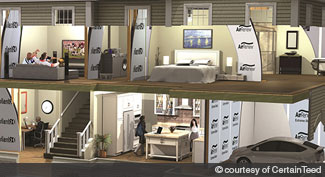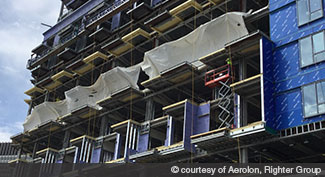Wall choices may seem ho-hum and routine. But innovative design professionals and entrepreneurs have developed new choices that you as a real estate professional should know about. With a recent onslaught of hurricanes and storms, anxious clients may be interested in products that can help a house better thwart high winds and rain or discourage mold growth in flood situations. Also, Eric Corey Freed, founding principal of Organic Architect in Portland, Ore., recommends real estate professionals learn what’s available for environmental- and health-conscious consumers, such as recycled options that keep raw materials out of landfills, concrete walls that “eat” carbon to remove it from a room’s air supply, and tiles that decoratively cover walls while eliminating contaminating gases for those highly sensitive to certain chemicals.
Many architects, builders, and engineers test their ideas as commercial and industrial wall designs, and then, if they work, adapt them for residential use. However, not every innovation works for every home. Some options won’t meet local building codes or offer a good return on investment, says Erin Hatcher, vice president of sustainability at AMLI Residential, a Chicago-based development and management company.
Here are six options that will expand your wall knowledge to fit today’s market options.
Living “Green Walls”
This product is actually something of a misnomer in that it’s more of a host for living plants than an actual “living wall.” The greenery doesn’t make up the actual wall support, but rather adds a living cover to a small wall area or expanse, which offers structural and nutritional support. Some popular plant choices include philodendron, pothos, and spider plants. In an exterior wall, homeowners should select plants based on a home’s USDA zone. For interior walls, the amount of light plants need should be the determining factor.
Why it’s noteworthy: When used outdoors, living walls can protect structures from inclement weather and ultraviolet rays. Indoors, they’re prized for their ability to remove toxins, add pleasant smells and textures, and even improve residents’ mental health. “Living plants have been shown to improve a person’s mood and increase productivity,” says Matthew Hills, a project manager with Ambius in Redding, Penn., an industry leader in this field. He advises grouping different plants on the same wall to help mitigate a variety of pollutants. “A spider plant removes carbon dioxide twice as much as a philodendron does,” he notes. The NASA Clean Air Study offers a list of common indoor plants and the toxins they can remove from the air. Finally, Mike Haynes—sales and marketing coordinator with Livewall in Spring Lake, Mich., which provides support systems for green walls—adds that they can create an acoustic barrier for a more peaceful setting. Homeowners can purchase DIY kits or rely on garden professionals to build and plant the walls.
Price per square foot: Varies based on the size of the wall and options, such as built-in irrigation. Ambius’ options range from $80 to $200; maintenance visits are extra. Livewall’s range from $85 to $135.
Mycelium Panels and Insulation
The rootlike fibers of mushrooms, otherwise known as mycelium, are being used to create wall panels and tiles. Ecovative Design, an upstate New York firm, patented the technology after its mechanical engineer founders saw the promise of fungi as “nature’s glue.” The company grows the material in its factor by binding together agricultural waste substrates to the fungal fiber. Ecovative originally used the technology to create lightweight product packaging and insulation, but they recently began selling modular acoustical wall panels.
Why it’s noteworthy: Because the material is renewable and it helps create a new use for agricultural waste, it’s environmentally friendly on two accounts. The tiles’ all-natural origins mean they’re free of volatile organic compounds and other harmful materials. The finished product is also durable, water- and fire-resistant, and compostable.
Price per square foot: Ecovative’s 16-by-16-inch acoustical panels cost $22 each; they also offer a 10-pack of slightly smaller tiles (covering approximately 9 square feet) for $100. The company is still working on scaling its insulation offerings.
Recycled Fly Ash Products
This product recycles waste fly ash, a by-product of coal combustion, into an attractive building material that cuts like wood, can be painted, and is highly durable. One company, Boral TruExterior, uses 70 percent recycled fly ash to create siding for exterior walls, trim components, and interior wall beadboard. “It works better than cement fiberboard, an industry basic,” says architect Nate Kipnis, who focuses on sustainable architecture at his Chicago-based firm, Kipnis Architecture + Planning, and uses the siding and trim on several client projects.
Why it’s noteworthy: Traditional wood products used for siding and trim tend to rot over time and are susceptible to insect damage. By contrast, this material is highly durable and dimensionally stable. Also, the process of creating it removes troublesome fly ash from the waste stream by encapsulating it during the production process.
Price per square foot: About 30 percent more than cement fiberboard, according to Kipnis.
Formaldehyde-Eating Drywall
CertainTeed takes its gypsum board and incorporates a proprietary ingredient that converts formaldehyde—a common VOC—into two separate inert compounds. The product is known as AirRenew and can be used wherever standard drywall board is used, according to Kipnis. Not only is it notable for being free of formaldehyde, it also promises to improve interior air quality by absorbing formaldehyde gassed off by cabinetry, carpeting, paint, adhesives, and and other materials. Tom Prokop, CertainTeed’s innovation and product manager, says AirRenew has been created to continue working for decades, even if new products with formaldehyde are introduced into a room.
Why it’s noteworthy: It looks and weighs the same as drywall, making it ideal for homeowners sensitive to these compounds and similar toxins. “It adds a lot of benefit for a relatively low cost and is one of the cheapest upgrades when building or remodeling,” Prokop says.
Price per square foot: About 25 percent more than standard drywall board, according to Kipnis.
Barn Wood Wall Panels
Homeowners who are looking for a rustic, hand-hewn look might consider recycled barn wood. Several companies have taken this desirable material and made it easier to work with. Different companies offer slightly different takes on the concept.
Viridian Reclaimed Wood makes an easy do-it-yourself stick-and-peel paneling from fencing that it has dubbed “Good Neighbor,” after the Robert Frost poem. The Portland, Ore., company finishes the rustic material to be sure it’s fire-rated and offers it in different updated hues of natural, clear, Tiffany blue, white, and black. Another company,
Kith + Kin Walls, offers engineered wood planks that feature the texture of wood grain and color variations of reclaimed barn wood but are delivered in more consistent sizes than are found on barns to simplify installation. Home owners who like DIY work should know what’s involved. With Veridian’s materials, DIYers must use a razor knife to cut excess, then peel and stick the panels. Taking them down later is tougher, since they’re considered a semipermanent installation. “Walls would require patching,” says Veridian co-founder Pierce Henley. His company’s product also wouldn’t work on concrete walls. Kith + Kin’s barn wood planks come in planks that require using a nail gun and saw to install.
Why it’s noteworthy: Viridian’s panels are environmentally friendly and lack VOCs, and its adhesive is rated to last at least 10 years. Kith + Kin feature a soft backing to protect walls and increase sound insulation.
Price per square foot: Veridian’s are $10.50, while Kith + Kin’s come in a box of 20-square-foot lengths for $228.70. Both companies offer online calculators to measure how much wood is required.
Thermal Wall Insulator
Energy efficiency can take a big hit through what’s called “thermal bridging,” when one section of a wall conducts heat much quicker than another, leading to condensation and less comfortable interiors, especially in cold weather. Historically, builders have used insulation, thermal break pads, or specific framing techniques to mitigate this problem, but there’s a newer option that can be more easily applied to an existing structure. Aerolon coating—a VOC-free, resin-based product by the
Righter Group—uses Aerogel (produced by another company, Cabot Corp.) to manufacture its peel and stick tape that goes on walls, along with lintels and other architectural members, to thermally insulate them. The company uses the same Aerogel particle mixture in liquid form, which can be applied to achieve similar effects. Both the tape and fluid can be applied to steel, aluminum, concrete, wood, and other materials. “What the Aerogel particles do,” says Greg Pope, owner and president of the Righter Group in Wilmington, Mass., “is alter the surface temperature and slow heat transfer more efficiently than conventional foam and other insulation do, thereby helping the home retain energy.”
Why it’s noteworthy: One of the biggest problems with residential construction is condensation in wall cavities, which leads to mold and mildew. This helps prevent that from occurring, says Pope.
Price per square foot: $5.










